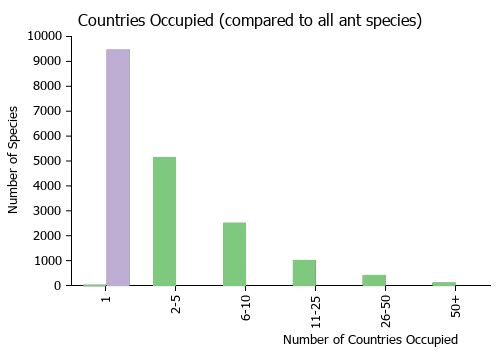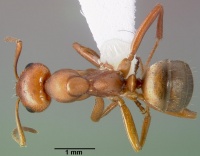Formica puberula
| Formica puberula | |
|---|---|

| |
| Scientific classification | |
| Kingdom: | Animalia |
| Phylum: | Arthropoda |
| Class: | Insecta |
| Order: | Hymenoptera |
| Family: | Formicidae |
| Subfamily: | Formicinae |
| Tribe: | Formicini |
| Genus: | Formica |
| Species: | F. puberula |
| Binomial name | |
| Formica puberula Emery, 1893 | |
This species nests under stones and logs. It enslaves Formica altipetens, Formica bradleyi, Formica densiventris, Formica hewitti, Formica lasioides, Formica lepida, Formica montana, Formica neoclara, Formica neorufibarbis, Formica occulta, Formica pallidefulva, Formica subpolita and Formica subaenescens (reported as Formica fusca) (Bono et al., 2006; Mackay & Mackay, 2002). It is known to be enslaved by Formica pergandei.
| At a Glance | • Dulotic |
Identification
The scape of this species has appressed to suberect, relatively coarse hairs, giving it a slight bristly appearance. The underside of the head has at least a pair of hairs. The erect hairs on the gaster are about 0.1 mm long, and are of about the same form and density as those on the pronotum. Most hairs have sharp tips. (Mackay and Mackay 2002)
Distribution
Western North America.
Latitudinal Distribution Pattern
Latitudinal Range: 53.726668° to 30.72°.
| North Temperate |
North Subtropical |
Tropical | South Subtropical |
South Temperate |
- Source: AntMaps
Distribution based on Regional Taxon Lists
Nearctic Region: United States (type locality).
Distribution based on AntMaps
Distribution based on AntWeb specimens
Check data from AntWeb
Countries Occupied
| Number of countries occupied by this species based on AntWiki Regional Taxon Lists. In general, fewer countries occupied indicates a narrower range, while more countries indicates a more widespread species. |

|
Estimated Abundance
| Relative abundance based on number of AntMaps records per species (this species within the purple bar). Fewer records (to the left) indicates a less abundant/encountered species while more records (to the right) indicates more abundant/encountered species. |

|
Habitat
In New Mexico (Mackay and Mackay 2002) - Sagebrush scrub and grasslands through mixed forests into ponderosa pine and aspen forests. This species also occurs in urban habitats.
Biology
This species is a member of a group of Formica species that were formerly placed in the subgenus Raptiformica. All species are facultative slavemakers, i.e., species which usually or often have slaves but can get along without them. The colony-founding female forces her way into a small colony of another species of Formica, somehow gets rid of its queen and workers and appropriates its nest and brood. The workers emerging from this brood accept the intruding queen as their own. The enslaved species belong to the Formica neogagates, fusca, and pallidefulva species groups. When the workers of the slave-making species have become numerous enough, they start raiding for more slaves.
Nevada, Wheeler and Wheeler (1986) - We have 11 records from 6 localities widely scattered north of the Hot Desert; 4,500-8,200 ft. Seven records are from the Coniferous Forest Biome, usually at the edge of mountain meadows; 2 are from disturbed habitats. We have descriptions of 2 nests: (1) under 2 stones 13 cm apart; (2) surmounted by a pile of excavated soil 22 x 28 cm around the base of an aspen tree, with the entrance near the trunk. We found Formica lasioides as slaves in 2 nests and Formica subsericea in 1.
Association with Other Organisms
 Explore: Show all Associate data or Search these data. See also a list of all data tables or learn how data is managed.
Explore: Show all Associate data or Search these data. See also a list of all data tables or learn how data is managed.
- This species is a mutualist for the aphid Aphis salicariae (a trophobiont) (Addicott, 1979a; Saddiqui et al., 2019).
- This species is a mutualist for the aphid Aphis varians (a trophobiont) (Addicott, 1979a; Saddiqui et al., 2019).
- This species is a mutualist for the aphid Rhopalosiphum nymphaeae (a trophobiont) (Jones, 1927; Saddiqui et al., 2019).
- This species is a host for the fungus Laboulbenia formicarium (a parasite) (Quevillon, 2018) (encounter mode primary; direct transmission; transmission within nest).
- This species is a host for the fungus Laboulbenia formicarum (a pathogen) (Espadaler & Santamaria, 2012).
Castes
Nomenclature
The following information is derived from Barry Bolton's Online Catalogue of the Ants of the World.
- puberula. Formica sanguinea subsp. puberula Emery, 1893i: 648 (w.) U.S.A. Wheeler, W.M. 1913f: 413 (q.m.). Combination in F. (Raptiformica): Emery, 1925b: 260. Raised to species: Creighton, 1950a: 468. Junior synonym of subintegra: Wilson & Brown, 1955: 120. Revived from synonymy: Buren, 1968a: 30.
Description
References
- Bono, J.M., Gordon, E.R., Antolin, M.F., Herbers, J.M. 2006. Raiding activity of an obligate (Polyergus breviceps) and two facultative (Formica puberula and F. gynocrates) slave-making ants. Journal of Insect Behavior 19, 429-446 (doi:10.1007/s10905-006-9035-2).
- Borowiec, M.L., Cover, S.P., Rabeling, C. 2021. The evolution of social parasitism in Formica ants revealed by a global phylogeny. Proceedings of the National Academy of Sciences 118, e2026029118 (doi:10.1073/pnas.2026029118).
- Buren, W. F. 1968a. Some fundamental taxonomic problems in Formica (Hymenoptera: Formicidae). J. Ga. Entomol. Soc. 3: 25-40 (page 30, revived from synonymy)
- Creighton, W. S. 1950a. The ants of North America. Bulletin of the Museum of Comparative Zoology 104: 1-585 (page 468, raised to species)
- de la Mora, A., Sankovitz, M., Purcell, J. 2020. Ants (Hymenoptera: Formicidae) as host and intruder: recent advances and future directions in the study of exploitative strategies. Myrmecological News 30: 53-71 (doi:10.25849/MYRMECOL.NEWS_030:053).
- Emery, C. 1893k. Beiträge zur Kenntniss der nordamerikanischen Ameisenfauna. Zool. Jahrb. Abt. Syst. Geogr. Biol. Tiere 7: 633-682 (page 648, worker described)
- Emery, C. 1925d. Hymenoptera. Fam. Formicidae. Subfam. Formicinae. Genera Insectorum 183: 1-302 (page 260, Combination in F. (Raptiformica))
- Espadaler, X., Santamaria, S. 2012. Ecto- and Endoparasitic Fungi on Ants from the Holarctic Region. Psyche Article ID 168478, 10 pages (doi:10.1155/2012/168478).
- Mackay, W. P. and E. Mackay. 2002. The ants of New Mexico (Hymenoptera: Formicidae). Edwin Mellen Press, Lewiston, NY.
- Rericha, L. 2007. Ants of Indiana. Indiana Department of Natural Resources, 51pp.
- Siddiqui, J. A., Li, J., Zou, X., Bodlah, I., Huang, X. 2019. Meta-analysis of the global diversity and spatial patterns of aphid-ant mutualistic relationships. Applied Ecology and Environmental Research 17: 5471-5524 (doi:10.15666/aeer/1703_54715524).
- Wheeler, G. C. and J. Wheeler. 1986. The ants of Nevada. Natural History Museum of Los Angeles County, Los Angeles.
- Wheeler, W. M. 1913i. A revision of the ants of the genus Formica (Linné) Mayr. Bulletin of the Museum of Comparative Zoology 53: 379-565 (page 413, queen, male described)
- Wilson, E. O.; Brown, W. L., Jr. 1955. Revisionary notes on the sanguinea and neogagates groups of the ant genus Formica. Psyche (Camb.) 62: 108-129 (page 120, Junior synonym of subintegra)
References based on Global Ant Biodiversity Informatics
- Allred D. M. 1982. Ants of Utah. The Great Basin Naturalist 42: 415-511.
- Allred, D.M. 1982. The ants of Utah. Great Basin Naturalist 42:415-511.
- Borchert, H.F. and N.L. Anderson. 1973. The Ants of the Bearpaw Mountains of Montana (Hymenoptera: Formicidae). Journal of the Kansas Entomological Society 46(2):200-224
- Buren W. F. 1968. Some fundamental taxonomic problems in Formica (Hymenoptera: Formicidae). J. Georgia Entomol. Soc. 3: 25-40
- Cole A. C., Jr. 1942. The ants of Utah. American Midland Naturalist 28: 358-388.
- Cole, A.C. 1936. An annotated list of the ants of Idaho (Hymenoptera; Formicidae). Canadian Entomologist 68(2):34-39
- Glasier J. R. N., S. Nielsen, J. H. Acorn, L. H. Borysenko, and T. Radtke. 2016. A checklist of ants (Hymenoptera: Formicidae) of Saskatchewan. The Canadian Field-Naturalist 130(1): 40-48.
- Gregg, R.T. 1963. The Ants of Colorado.
- Johnson R. Personnal Database. Accessed on February 5th 2014 at http://www.asu.edu/clas/sirgtools/resources.htm
- Knowlton G. F. 1970. Ants of Curlew Valley. Proceedings of the Utah Academy of Sciences, Arts and Letters 47(1): 208-212.
- La Rivers I. 1968. A first listing of the ants of Nevada. Biological Society of Nevada, Occasional Papers 17: 1-12.
- Longino, J.T. 2010. Personal Communication. Longino Collection Database
- Mackay W. P., and E. E. Mackay. 2002. The ants of New Mexico (Hymenoptera: Formicidae). Lewiston, New York: Edwin Mellen Press, 400 pp.
- Michigan State University, The Albert J. Cook Arthropod Research Collection. Accessed on January 7th 2014 at http://www.arc.ent.msu.edu:8080/collection/index.jsp
- O'Keefe S. T., J. L. Cook, T. Dudek, D. F. Wunneburger, M. D. Guzman, R. N. Coulson, and S. B. Vinson. 2000. The Distribution of Texas Ants. The Southwestern Entomologist 22: 1-92.
- Rees D. M., and A. W. Grundmann. 1940. A preliminary list of the ants of Utah. Bulletin of the University of Utah, 31(5): 1-12.
- Smith M. R. 1952. On the collection of ants made by Titus Ulke in the Black Hills of South Dakota in the early nineties. Journal of the New York Entomological Society 60: 55-63.
- Snelling R. R. 1969. Notes on the systematics and dulosis of some western species of Formica, subgenus Raptiformica (Hymenoptera: Formicidae). Proceedings of the Entomological Society of Washington 71: 194-197.
- Wheeler G. C., and J. Wheeler. 1986. The ants of Nevada. Los Angeles: Natural History Museum of Los Angeles County, vii + 138 pp.
- Wheeler G. C., and J. Wheeler. 1987. A Checklist of the Ants of South Dakota. Prairie Nat. 19(3): 199-208.
- Wheeler J. N., G. C. Wheeler, R. J. Lavigne, T. A. Christiansen, and D. E. Wheeler. 2014. The ants of Yellowstone National Park. Lexington, Ky. : CreateSpace Independent Publishing Platform, 2013. 112 pages.
- Wheeler W. M. 1913. A revision of the ants of the genus Formica (Linné) Mayr. Bulletin of the Museum of Comparative Zoology 53: 379-565.
- Wheeler W. M. 1917. The mountain ants of western North America. Proceedings of the American Academy of Arts and Sciences 52: 457-569.
- Wheeler, G.C. and J. Wheeler. 1978. Mountain ants of Nevada. Great Basin Naturalist 35(4):379-396
- Wheeler, G.C. and J. Wheeler. 1985. A checklist of Texas ants. Prairie Naturalist 17:49-64.
- Wheeler, G.C. and J. Wheeler. 1988. A checklist of the ants of Montana. Psyche 95:101-114
- Wheeler, G.C. and J. Wheeler. 1988. A checklist of the ants of Wyoming. Insecta Mundi 2(3&4):230-239
- Wheeler, G.C., J. Wheeler, T.D. Galloway and G.L. Ayre. 1989. A list of the ants of Manitoba. Proceedings of the Entomological Society of Manitoba 45:34-49
- Pages using DynamicPageList3 parser function
- Ant Associate
- Host of Formica altipetens
- Host of Formica bradleyi
- Host of Formica densiventris
- Host of Formica hewitti
- Host of Formica lasioides
- Host of Formica lepida
- Host of Formica montana
- Host of Formica neoclara
- Host of Formica neorufibarbis
- Host of Formica occulta
- Host of Formica pallidefulva
- Host of Formica subpolita
- Host of Formica subaenescens
- Host of Formica pergandei
- Dulotic
- Need species key
- North temperate
- North subtropical
- Aphid Associate
- Host of Aphis salicariae
- Host of Aphis varians
- Host of Rhopalosiphum nymphaeae
- Fungus Associate
- Host of Laboulbenia formicarium
- Host of Laboulbenia formicarum
- Species
- Extant species
- Formicidae
- Formicinae
- Formicini
- Formica
- Formica puberula
- Formicinae species
- Formicini species
- Formica species
- Need Body Text
- Sanguinea group

